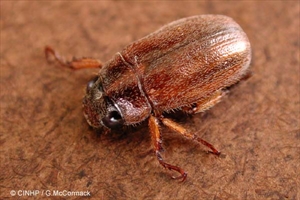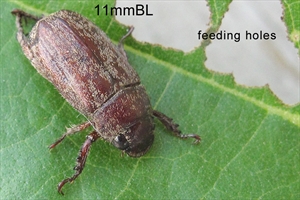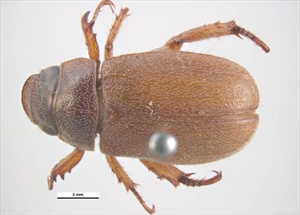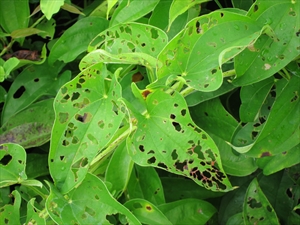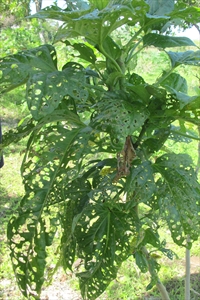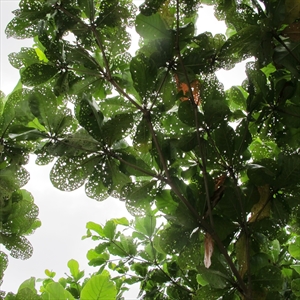Rose beetle
Pacific Pests, Pathogens, Weeds & Pesticides - Online edition
Pacific Pests, Pathogens, Weeds & Pesticides
Rose beetle (107)
Adoretus versutus
Asia, Africa (nations of the Indian Ocean), Oceania. It is recorded from American Samoa, Cook Islands, Fiji, Samoa, Tonga, Vanuatu, and Wallis & Futuna.
Cocoa, coffee, bele, yams, many other crops, ornamentals and trees, e.g., Hibiscus tiliaceus.
The adult beetles (Photos 1&2) do the damage, feeding in the early hours of the night. As they eat, they make holes in young to middle-aged leaves (Photos 3-6). They do not always eat the midribs and veins, so the leaves look sieve-like or skeletonised.
Brown oval eggs (1.5-2 mm long) are laid singly in the soil at a depth of 7-10 cm. They hatch in 1-2 weeks, depending on temperature, producing C-shaped, fleshy, whitish grubs with strong legs that go through three stages or instars. The grubs feed on organic matter and roots. Two pupal stages follow, lasting about 25 days, before adults emerge. The adult rose beetles are about 12.5 mm long and 6.5 mm wide, dark brown covered with dense greyish-white scales dotted with brown-red hairs. The whole life cycle takes about 80 days in Samoa.
In the daytime, the beetles shelter in the soil or under leaves, stones and logs. However, the beetles are attracted to lights at night.
The damage is locally very important in Fiji, Samoa and Tonga. In Fiji, cocoa seedlings and plants in the field up to 18-months-old are especially vulnerable to attack, with 10-15% of young trees killed. Tonga has recorded damage to beans, grapevines, ginger and yams.
Look for brown beetles covered with grey-white scales; look for the characteristic damage to the leaves where the beetles make numerous holes, but leave the veins untouched. Remove the soil to a depth of 10 cm from around the base of affected plants and look for the C-shaped larvae with orange head capsules. Look for the beetles feeding at night.
The rose beetle is difficult to control because a considerable part of its life cycle occurs in the soil.
QUARANTINE
There are some Pacific island countries where the rose beetle is not yet present. Biosecurity agencies in those countries should consider the potential pathways for introduction and take the necessary precautions. The beetle is not in Solomon Islands, nor Papua New Guinea.
NATURAL ENEMIES
A scoliid wasp, Micromeriella margiinella modesta, was introduced into Fiji from Hawaii in 1917, and later into Samoa (1955) and Solomon Islands (1984). In Fiji, it was introduced primarily against a beetle (Xenotrogus) of sugarcane. Two fungi were also introduced from Hawaii into Fiji. There is no evidence that the wasp reduced populations of rose beetle or that the fungi became established. In Samoa, trials showed that the rose beetle could be killed by the baculovirus (now called Oryctes rhinoceros nudivirus) used against Oryctes, and by the fungus, Metarhizium anisopliae.
CULTURAL CONTROL
- Use barriers (e.g., coconut fronds, bamboo, stones) around cocoa seedlings planted in the field, making sure they are at least as tall as the foliage.
- Use shade in cocoa plantations: if the shade is more than 30-40%, the damage from rose beetle is usually low.
- Handpick and destroy adult beetles that come to light sources as night. Note, in Samoa, grubs have been found crawling on soil at night, although it is not known whether they were doing this to find food or to escape overcrowding.
- Do not plant near living fences of Hibiscus tiliaceous if these trees show symptoms of rose beetle leaf damage.
RESISTANT VARIETIES
None known
CHEMICAL CONTROL
In Tonga, malathion is used on yams when leaf damage is about 30%. The insecticide is applied in the late afternoon. Trials in Samoa showed that acephate and permethrin were superior to malathion. It is likely that synthetic pyrethroids would be suitable.
____________________
When using a pesticide, always wear protective clothing and follow the instructions on the product label, such as dosage, timing of application, and pre-harvest interval. Recommendations will vary with the crop and system of cultivation. Expert advice on the most appropriate pesticide to use should always be sought from local agricultural authorities.
AUTHOR Grahame Jackson
Information from Waterhouse DF, Norris KR (1987) Adoretus versutus Harold. Biological Control Pacific Prospects. Inkata Press. Melbourne. Photo 1&2 Gerald McCormack, Cook Islands Biodiversity & Natural Heritage (http://cookislands.bishopmuseum.org/). Photo 3&4 Walker K (2007) Adoretus versutus. PaDIL - (http://www.padil.gov.au). Photo 5 Richard Markham, ACIAR, Canberra.
Produced with support from the Australian Centre for International Agricultural Research under project PC/2010/090: Strengthening integrated crop management research in the Pacific Islands in support of sustainable intensification of high-value crop production, implemented by the University of Queensland and the Secretariat of the Pacific Community.
